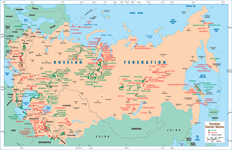FSU/ Eastern Europe: Turkmenistan
Aug. 2001 Vol. 222 No. 8 International Outlook FSU/EASTERN EUROPE Russia, Turkmenistan, Uzbekistan, Ukraine, Belarus and Lithuania by Alec Mikhalyants , Igor Pol
FSU/EASTERN EUROPERussia, Turkmenistan, Uzbekistan, Ukraine, Belarus and Lithuania by Alec Mikhalyants, Igor Polovets and Alex Chorine, RPI, Inc., a U.S.-Russian consulting firm, Moscow and Los Angeles TurkmenistanThe major event in Turkmenistan’s E&P industry last year was a drastic increase in gas production. Output jumped 106%, to 47 Bcm (4.5 Bcfd). Exports of gas, the country’s main commodity, increased 288%, to 33 Bcm (3.2 Bcfd). The large export increase was due to new contracts signed with Gazprom, Russia’s gas monopoly, and with Itera, a Russian group that supplies gas to other FSU states.
Turkmenistan had also pinned its hopes on constructing a 16-Bcm/year (1.55-Bcfd) gas pipeline across the Caspian Sea. The Transcaspian pipeline would provide a stable export outlet for Turkmen gas and lessen dependence on export contracts with Russia. However, prospects for the pipeline dimmed when, in mid-2000, Shell withdrew from the project. In the absence of new export routes, Turkmenistan’s gas output remained highly dependent on export contracts. To alleviate the situation, officials began investing in the building of gas liquefaction facilities. Exploration. Reserves are concentrated in two primary provinces, Amudaria and South-Caspian. The former is gas-bearing, the latter is mostly oil-bearing. Although substantial reserves have already been discovered, less than 30% of national territory has been explored. Turkmenistan retains good potential for new, large-scale discoveries. Preliminary exploration work also indicates substantial resources are on the Caspian Sea shelf. Hypothetical resources in Turkmenistan’s section are estimated at 12 billion toe (87 billion boe). At the end of 2000, Turkmenistan had 134 discovered fields, including 127 onshore and seven offshore, on the Caspian shelf. Of these, 49 were developed – 46 onshore and three offshore. There were 65 fields being explored, including 61 onshore and four offshore. Exploration efforts last year produced 4.7 million t (34.2 million bbl) of new oil reserves, compared to 3.2 million t (23.3 million bbl) added in 1999. There were 33.9 Bcm (1.197 Tcf) of new gas reserves discovered in 2000, a slight increase compared to 33.1 Bcm (1.169 Tcf) found in 1999. During first-half 2000, ExxonMobil began exploring the Garashyzlyk-2 Block, onshore. Signed in 1999, the project’s goal is to develop the block’s lower horizons and adjacent territories. Valued at $15 billion over its life, the project seeks to find reserves equal to 1 billion toe. However, ExxonMobil last October suspended exploration, asking for governmental clarification of the expected work pace for this tract. Drilling / development. There was a moderate rise in drilling last year. State exploration firm Turkmengeologiya drilled 27,000 m (88,587 ft), up from 14,000 m (45,934 ft) drilled in 1999. The company drilled seven new wells, of which six were productive. Total exploratory drilling for Turkmenistan was 55,900 m (183,408 ft), compared to 37,800 m (124,022 ft) in 1999. Dragon Oil, operator of the Cheleken II project offshore, began drilling its first well on the LAM Block. The production-sharing project, dating to 1993 (initially with a different operator), has been moving slowly. Total investment in the block, estimated to hold 82 million t of oil (596 million bbl) and 2 Tcf of associated gas, stood at only $17 million by the end of 2000. However, the operator planned to finish drilling the first well and drill two more wells in 2001. Dragon Oil plans to invest $110 million on developing Cheleken II this year. The project to develop the Cheleken I Block, located near Cheleken II, has also been slow-moving. Operator of the project, Malaysia’s Petronas Carigali, drilled one well and suspended further drilling since then. Drilling results were successful, but the company is reportedly waiting for governmental guarantees that it will be allowed to export gas produced at the fields. Production. Oil output increased slightly, to 7.1 million t (141,030 bpd) in 2000 from 7.0 million t (139,425 bpd) in 1999. The production increase came from output operated by state firm Turkmenneft. Oil production from blocks developed by foreign investors was 220,000 t (4,370 bpd). Condensate production rose to 173,000 t (3,781 bpd) in
2000, from 86,400 t (1,894 bpd) in 1999. Turkmenistan had 2,373 oil wells capable of producing, of which 1,928
were active. Of these, 261 were flowing, and 1,667 were on artificial lift.
|
- Applying ultra-deep LWD resistivity technology successfully in a SAGD operation (May 2019)
- Adoption of wireless intelligent completions advances (May 2019)
- Majors double down as takeaway crunch eases (April 2019)
- What’s new in well logging and formation evaluation (April 2019)
- Qualification of a 20,000-psi subsea BOP: A collaborative approach (February 2019)
- ConocoPhillips’ Greg Leveille sees rapid trajectory of technical advancement continuing (February 2019)



